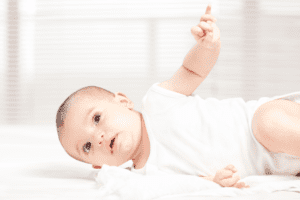Facilitating QUALITY Movement in Children
Fitness trainers always stress the importance of quality of movement in exercise performance to their adult participants. Completing more repetitions is not better if the quality of the exercise is poor. Poor exercise and lack of quality movement could cause damage in a variety of ways, including:
- Muscle Imbalances
- Torque on the Spine
- Increased Pressure on the Joints
It’s The Same In Kids!
As children grow and develop they learn what movement pattern (i.e. how to turn, rotate and stretch their bodies) will most effectively and efficiently help them to meet their goal. The goals of a child are simple – to move, to play with toys, and to interact with friends. Some children may learn to achieve a skill utilizing poor movement quality, which can cause damage in just the same way as it does in adults. There are many examples throughout development where asymmetries and muscle imbalances may occur. The movement pattern that is developed and practiced at a young age can stay throughout a child’s development, which is why it is imperative to catch – and correct- them early!
EXAMPLE #1: Rolling
Between the ages of 3-6 months, children become confident rollers. Frequently, a children will roll in only one direction (i.e. for example always to the right). This early asymmetry can have a detrimental effect, for instance:

- Increased flexibility and decreased strength on one side of the neck, with decreased flexibility and strength on the opposite side. This can cause spinal asymmetry as well as torticollis, which is a condition where a child develops asymmetrical tightness of the sternocleidomastoid muscle.
- Asymmetrical strength of the abdominals, hip flexors and hip extensors, as they are only using one side to propel them from their backs to their bellies.
Ways to correct: Encourage symmetry, even in newborns. Though children will eventually develop a hand preference, when they are developing new skills we want them to have equal practice to develop strength and flexibility on each side of their body.
Example #2: ‘W’ sitting
When a child ‘W’ sits, their base of support is very wide, making it difficult to transition out of sitting, as well as utilize their trunk and hip muscles. This can have a detrimental effect on development, including:

- Weakened abdominal and hip muscles. When a child sits with their legs in front of them, they will have multiple repetitions transitioning on a diagonal over their hip, which strengthens their core musculature.
- Excessive torsion force on the femur. The forces applied to the bone by the muscles during play affect the bony development. If a child continually utilizes positions where their thigh bone is turned inwards, the leg will continue to develop this way and the child’s legs will looked turned inwards when standing.
Ways to correct: Encourage children to sit with their legs in front of them, cross-legged or up on a small stool with their feet planted on the floor.
Example #3: Bottom Scooting
Some children teach themselves to scoot on their bottoms, instead of crawl, in order to maneuver around their environment. Though they can be very efficient, this causes:
- Asymmetrical weightbearing on the arms and hips, leading to muscle weakness in the under-used arm and leg.
- Decreased opportunity for strengthening of the abdominals and hip musculature. Bottom scooting does not require a child to transition from sitting to all-4’s over their hips, eliminating the opportunity for hip strengthening.
Ways to correct: Place your child in a crawling position and have them attempt to climb over obstacles such as pillows or couch cushions on the floor. It is near impossible to scoot over these hurdles.

These three examples highlight some instances where quality of movement is valued over quantity. Just as in adults, quality is important for children to develop life-long good alignment and posture.
More Questions and Concerns
Children are at a fast pace of learning when they finally become mobile! Movement is exciting for all involved, but we want to make sure your child is not “practicing” poor movement patterns. Especially not all day long! Remember, quality movement now means quality movement later! If you see any concerns with your mover, please call the specialists at our clinic for a physical therapy assessment. We will help get your little one back on track!
We can be reached at 773-687-9241 or info@cptwc.com. Happy moving!


